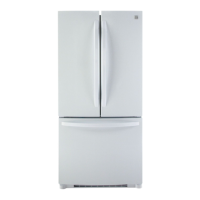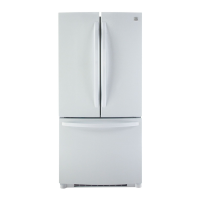Do you have a question about the Kenmore 795.7130-K and is the answer not in the manual?
Describes the duration and conditions of the warranty for defects in material or workmanship.
Details benefits and terms of the protection plan, including expert service and guarantees.
Explains safety alert symbols, signal words (DANGER, WARNING, CAUTION), and hazard communication.
Lists essential precautions for using the refrigerator safely, covering electrical and operational hazards.
Warnings about child safety hazards and proper disposal of refrigerants.
Explains grounding requirements and electrical shock hazards for safe operation.
Labels and describes various parts of the refrigerator for user familiarity.
Instructions for removing packaging, cleaning, and initial preparation for use.
Guidelines for choosing a suitable location and ensuring the unit is level.
Lists necessary tools for setting up the refrigerator, such as wrenches and screwdrivers.
Step-by-step guide for detaching refrigerator and freezer door handles using specific tools.
Detailed steps for safely removing the left refrigerator door, including hinge and wire disconnects.
Detailed steps for safely removing the right refrigerator door, including hinge and wire disconnects.
Instructions for reinstalling the right refrigerator door, ensuring proper alignment and seal.
Instructions for reinstalling the left refrigerator door, ensuring proper alignment and seal.
Step-by-step guide for safely detaching the lower pull-out drawer from its rails.
Instructions for reassembling the pull-out drawer, including rail and cover alignment.
Instructions for adjusting the unit's tilt for proper operation and door closure.
Steps to ensure refrigerator doors close properly and maintain an even seal.
Explains proper air flow for cooling and the function of the door alarm.
Guide to adjusting refrigerator and freezer temperatures for optimal cooling.
Advice on fine-tuning temperatures for optimal food storage and cooling.
Recommendations for storing various food items to maintain freshness and prevent odors.
Guidance on preserving fruits, vegetables, fish, and leftovers for freshness.
Best practices for packaging and storing food in the freezer to prevent spoilage.
Instructions on how to remove, adjust, and replace glass shelves for storage needs.
Information on special shelf types like sliding and folding shelves and their use.
Details on using the pantry and adjusting crisper humidity for fruit and vegetables.
Features and operation of the OptiBin Crisper system for enhanced freshness.
How to manage crisper covers with lattice and remove/replace modular door bins.
Guidance on using the dairy bin, egg box, and managing the freezer's ice bin.
Instructions for organizing the freezer drawer using dividers and baskets.
Tips for cleaning interior, exterior, plastic parts, and condenser coils.
Instructions on how to safely replace burnt-out light bulbs in the refrigerator.
Advice on food safety during power outages and how to prepare for extended outages.
Steps for leaving the refrigerator unused or preparing it for relocation.
Instructions and warnings for using the automatic icemaker and its power switch.
Explains normal sounds, when to turn off the icemaker, and vacation preparation.
Important notes and warnings before connecting the water supply to prevent damage.
Lists items needed for installing the water supply line, including tubing and fittings.
Procedures for stopping water supply and preparing the pipe for valve installation.
Steps for laying out and connecting the water tubing to the shutoff valve and refrigerator.
Instructions for attaching the water line to the appliance's water valve connection.
Steps to supply water, check for leaks, and activate the icemaker.
Explains common noises the refrigerator might make and their causes.
Diagnosing and resolving issues when the unit is not running or displaying 'OFF'.
Solutions for non-working lights and excessive compressor run time.
Diagnosing and fixing issues with doors not shutting completely, including leveling.
Addressing frost, off-tastes, or odors in frozen food and storage.
Resolving slow ice production, small cubes, and difficult door opening.
Steps to diagnose and fix common icemaker failures and operational issues.
Resolving problems with warm temperatures or excess interior moisture build-up.
Describes the duration and conditions of the warranty for defects in material or workmanship.
Details benefits and terms of the protection plan, including expert service and guarantees.
Explains safety alert symbols, signal words (DANGER, WARNING, CAUTION), and hazard communication.
Lists essential precautions for using the refrigerator safely, covering electrical and operational hazards.
Warnings about child safety hazards and proper disposal of refrigerants.
Explains grounding requirements and electrical shock hazards for safe operation.
Labels and describes various parts of the refrigerator for user familiarity.
Instructions for removing packaging, cleaning, and initial preparation for use.
Guidelines for choosing a suitable location and ensuring the unit is level.
Lists necessary tools for setting up the refrigerator, such as wrenches and screwdrivers.
Step-by-step guide for detaching refrigerator and freezer door handles using specific tools.
Detailed steps for safely removing the left refrigerator door, including hinge and wire disconnects.
Detailed steps for safely removing the right refrigerator door, including hinge and wire disconnects.
Instructions for reinstalling the right refrigerator door, ensuring proper alignment and seal.
Instructions for reinstalling the left refrigerator door, ensuring proper alignment and seal.
Step-by-step guide for safely detaching the lower pull-out drawer from its rails.
Instructions for reassembling the pull-out drawer, including rail and cover alignment.
Instructions for adjusting the unit's tilt for proper operation and door closure.
Steps to ensure refrigerator doors close properly and maintain an even seal.
Explains proper air flow for cooling and the function of the door alarm.
Guide to adjusting refrigerator and freezer temperatures for optimal cooling.
Advice on fine-tuning temperatures for optimal food storage and cooling.
Recommendations for storing various food items to maintain freshness and prevent odors.
Guidance on preserving fruits, vegetables, fish, and leftovers for freshness.
Best practices for packaging and storing food in the freezer to prevent spoilage.
Instructions on how to remove, adjust, and replace glass shelves for storage needs.
Information on special shelf types like sliding and folding shelves and their use.
Details on using the pantry and adjusting crisper humidity for fruit and vegetables.
Features and operation of the OptiBin Crisper system for enhanced freshness.
How to manage crisper covers with lattice and remove/replace modular door bins.
Guidance on using the dairy bin, egg box, and managing the freezer's ice bin.
Instructions for organizing the freezer drawer using dividers and baskets.
Tips for cleaning interior, exterior, plastic parts, and condenser coils.
Instructions on how to safely replace burnt-out light bulbs in the refrigerator.
Advice on food safety during power outages and how to prepare for extended outages.
Steps for leaving the refrigerator unused or preparing it for relocation.
Instructions and warnings for using the automatic icemaker and its power switch.
Explains normal sounds, when to turn off the icemaker, and vacation preparation.
Important notes and warnings before connecting the water supply to prevent damage.
Lists items needed for installing the water supply line, including tubing and fittings.
Procedures for stopping water supply and preparing the pipe for valve installation.
Steps for laying out and connecting the water tubing to the shutoff valve and refrigerator.
Instructions for attaching the water line to the appliance's water valve connection.
Steps to supply water, check for leaks, and activate the icemaker.
Explains common noises the refrigerator might make and their causes.
Diagnosing and resolving issues when the unit is not running or displaying 'OFF'.
Solutions for non-working lights and excessive compressor run time.
Diagnosing and fixing issues with doors not shutting completely, including leveling.
Addressing frost, off-tastes, or odors in frozen food and storage.
Resolving slow ice production, small cubes, and difficult door opening.
Steps to diagnose and fix common icemaker failures and operational issues.
Resolving problems with warm temperatures or excess interior moisture build-up.
| Brand | Kenmore |
|---|---|
| Model | 795.7130-K |
| Category | Refrigerator |
| Language | English |












